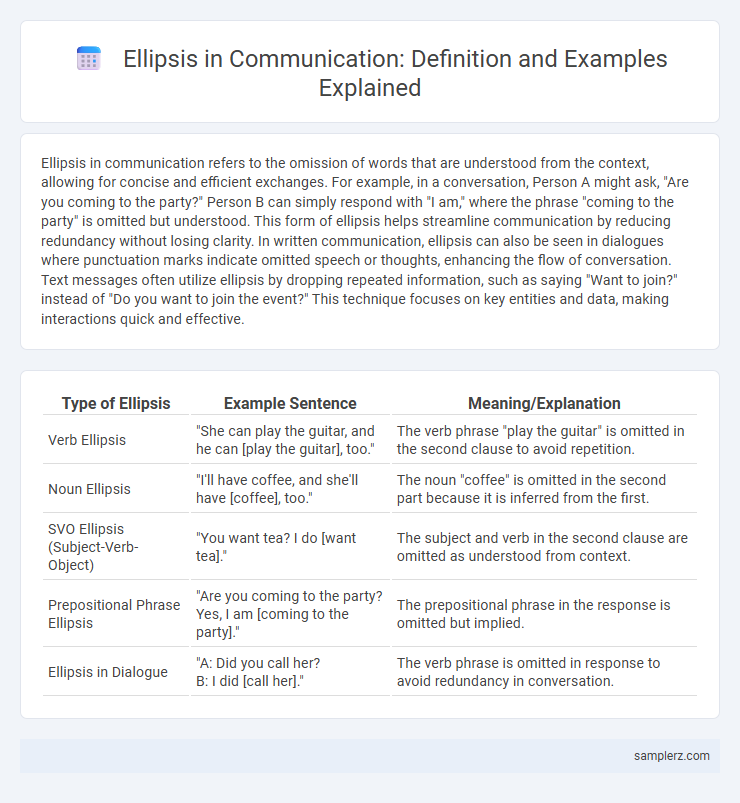Ellipsis in communication refers to the omission of words that are understood from the context, allowing for concise and efficient exchanges. For example, in a conversation, Person A might ask, "Are you coming to the party?" Person B can simply respond with "I am," where the phrase "coming to the party" is omitted but understood. This form of ellipsis helps streamline communication by reducing redundancy without losing clarity. In written communication, ellipsis can also be seen in dialogues where punctuation marks indicate omitted speech or thoughts, enhancing the flow of conversation. Text messages often utilize ellipsis by dropping repeated information, such as saying "Want to join?" instead of "Do you want to join the event?" This technique focuses on key entities and data, making interactions quick and effective.
Table of Comparison
| Type of Ellipsis | Example Sentence | Meaning/Explanation |
|---|---|---|
| Verb Ellipsis | "She can play the guitar, and he can [play the guitar], too." | The verb phrase "play the guitar" is omitted in the second clause to avoid repetition. |
| Noun Ellipsis | "I'll have coffee, and she'll have [coffee], too." | The noun "coffee" is omitted in the second part because it is inferred from the first. |
| SVO Ellipsis (Subject-Verb-Object) | "You want tea? I do [want tea]." | The subject and verb in the second clause are omitted as understood from context. |
| Prepositional Phrase Ellipsis | "Are you coming to the party? Yes, I am [coming to the party]." | The prepositional phrase in the response is omitted but implied. |
| Ellipsis in Dialogue | "A: Did you call her? B: I did [call her]." |
The verb phrase is omitted in response to avoid redundancy in conversation. |
Understanding Ellipsis in Everyday Communication
Ellipsis in communication occurs when speakers omit words that are implied by context, such as responding to "Are you coming?" with just "Yes" instead of "Yes, I am coming." This linguistic shortcut enhances conversational efficiency and reflects shared understanding between participants. Recognizing ellipsis helps improve clarity and reduces redundancy in everyday interactions.
Key Functions of Ellipsis During Conversations
Ellipsis in communication streamlines conversations by omitting redundant words, enhancing efficiency and promoting clarity. It facilitates quick understanding, reinforces shared knowledge between speakers, and maintains conversational flow without unnecessary repetition. This function supports pragmatics by allowing interlocutors to convey meaning through context, reducing cognitive load and fostering engagement.
Common Situations Where Ellipsis Occurs
Ellipsis commonly occurs in everyday conversations, such as when answering questions with short responses like "Want coffee?" instead of "Do you want coffee?" It frequently appears in text messages or informal emails where brevity is valued, e.g., "Running late, sorry!" omitting subjects and auxiliary verbs. In spoken communication, ellipsis helps streamline dialogue by removing redundant words, as in "Going to the store?" instead of "Are you going to the store?
Ellipsis in Written vs. Spoken Communication
In written communication, ellipsis often indicates omitted text or a trailing thought, enhancing clarity and conciseness, such as in formal reports or emails. In spoken communication, ellipsis reflects natural pauses or hesitation, contributing to conversational tone and emotional nuance during dialogues or interviews. Understanding these differences aids in interpreting intent and meaning across various communication contexts.
Pragmatic Effects of Ellipsis in Dialogue
Ellipsis in communication often omits redundant information, streamlining dialogue and enhancing efficiency. This pragmatic effect allows interlocutors to convey meaning and maintain coherence without restating known context, fostering a more natural and dynamic interaction. The strategic use of ellipsis can also signal shared understanding and intimacy between speakers, reinforcing social bonds.
Cultural Variations in the Use of Ellipsis
Ellipsis in communication varies significantly across cultures, reflecting differing norms of politeness and indirectness. In Japanese, ellipsis often conveys humility or softens requests, avoiding direct statements to maintain harmony. Conversely, Western cultures may use ellipsis to imply hesitation or an unfinished thought, highlighting differences in pragmatic interpretation.
Ellipsis for Politeness and Implicit Meaning
Ellipsis in communication often serves as a strategic tool to convey politeness by omitting potentially face-threatening elements, making requests or statements less direct and thus softer. For instance, saying "Want some tea?" instead of "Do you want some tea?" implicitly respects the listener's autonomy and reduces imposition. This use of ellipsis fosters implicit meaning, enhancing social harmony by allowing speakers to convey intentions subtly without explicit commands or questions.
Role of Ellipsis in Digital Communication
Ellipsis plays a crucial role in digital communication by enabling brevity and maintaining conversational flow, especially in text messaging and social media exchanges. By omitting redundant words, ellipsis helps streamline messages, making interactions faster and more efficient in platforms like Twitter or instant messaging apps. This linguistic feature enhances clarity while preserving the meaning, allowing users to convey thoughts succinctly without sacrificing comprehension.
Potential Misunderstandings Caused by Ellipsis
Ellipsis in communication often leads to potential misunderstandings when key information is omitted, causing ambiguity in message interpretation. For example, in customer service interactions, saying "Will do" without specifying what will be done can confuse the recipient about the intended action or timeframe. Clear and complete communication is essential to prevent errors and ensure mutual understanding.
Effective Strategies for Interpreting Ellipsis
Effective strategies for interpreting ellipsis in communication involve analyzing contextual cues and inferred meanings to fill in missing information. Skilled listeners rely on shared knowledge and situational awareness to decode omitted elements, enhancing understanding without explicit details. Utilizing context-based inference operators enables precise comprehension of elliptical expressions across varied communicative scenarios.

example of ellipsis in communication Infographic
 samplerz.com
samplerz.com